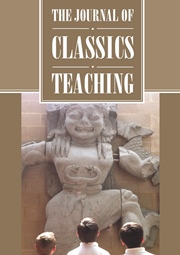
This book joins the other volumes in the ‘Ancient Wisdom for Modern Readers’ series, looking at how (some) people in ancient times thought that our choice and consumption of food could help us lead healthier lives. ‘Healthy eating’ is, as Bubb tells us right at the start, ‘a perennially urgent topic’ and this timely and fascinating book should find its place in the ‘nutritionist’ section of the library as well as in the section devoted to classics. The first section offers three extended accounts of the healthy lifestyle, while the second section homes in on different foods.
As with most other volumes in this series, the Greek and Latin texts are printed with a facing English translation provided by Bubb; and there is a wonderfully lucid 40-page introduction to orientate us before we chomp our way through the Greek and Latin. At the end of the book, Bubb gives us a helpful guide to further reading, a list of the editions of the ancient texts which she has used, and a few pages of endnotes picking up points from the text which merit further clarification. The book is illustrated with 11 monochrome images.
The texts selected are from a range of prose authors – Galen, Hippocrates, Diocles, Pliny, Celsus, Cato, Apicius, Dioscorides, and a dash of Plutarch and Seneca. The result aims to be ‘a smorgasbord’ (p. 43) but the restricted diet of factual prose could perhaps have done with peppering up with some poetry and more literary prose, as well as with some historical data. ‘Mushrooms can be fatal’ says Galen (p. 99) – a footnote referencing Claudius would have been good here. Juvenal (1.140–44) had a few choice things to tell us about the dangers of cardiac arrest if you go to the baths when stuffed with luxury food: Celsus says the same thing (p. 63) but Juvenal puts it more arrestingly. Lucretius (3.694) drops in the image of the rough gritty stone lurking in the slice of bread you bite down on. Habinnas boasts of eating bear meat in the course of his lively account of his own eating and toilet habits (Petronius Satyricon 66), which would have made a good addition to Galen’s account of ‘other meats’ (pp. 168–171): but space is limited in this series and Bubb wisely opts not to overface the reader with what Galen calls ‘pernicious seasonings’ (p. 195) instead of the wholesome and simple produce conducive to a healthy body – and a good book.
There are many choice pieces on the menu here, and the translation is excellent for accuracy and readability: where Diocles tells us that we should be κατὰ μικρὸν προσάγοντας, Bubb tells us to ‘ramp it up slowly’, and where Galen tells us that some cheese has δριμύτης, she renders this excellently as ‘funkiness’. Descendere in solium is rendered ‘go take a dip in the tub’ (p. 67). The translation does more than justice to the original and sells what can be in places clunky Greek and Latin in her own sparkling English prose.
One striking feature of at least some of the texts here is how clearly this writing is aimed at affluent villa-owning gentlefolk rather than the people who lived (and went hungry) in the cities or the countryside. Bubb acknowledges this, telling us correctly in her introduction (p. xxvii) that ‘the possibility of hunger would have lurked perpetually in the background for many’, but the daily routine described by Diocles is more like an expensive holiday in a spa resort than real life for the rest of us: no work is envisaged, just food, sleep, personal hygiene, and exercise (including sex, which is most beneficial for ‘cold, moist, melancholic and flatulent people’ [p. 45]). Romans, too, were conscious of this, and Seneca spells it out (pp. 194–197): we used to eat because we were hungry, but now we seek out foods to excite a jaded appetite, and the resulting casseroles (patinae) are like ‘vomited food’. While some people die of hunger, others effectively dig their grave with their teeth and die of overeating too many different foods all at once.
None of this is news, of course. The same issues still face a highly unequal world today, and Bubb is keen to share the insights of the ancient world rather than to pass judgement on them (or us). It is also salutary to remind ourselves that the greatest foody excitement found in this book comes in the paean to the humble cabbage by Cato (pp. 108–114).
There are astonishing points of contact with modern times: the snooze-button (p. 19), toothpaste with a fresh minty taste (p. 21), a vegetable Viagra (p.117), chicken soup for the sick (p. 183), athletes ‘going over the top’ with obsessive diet and exercise (p. 51), young people who can eat whatever they like and get away with it (p. 77). We do not now think (unlike Celsus [p. 72]) that sleep deprivation will help us lose weight, and most people would not practise nudity to lose weight even though Hippocrates (p.11) says we should. The bottom line, however, has not changed. ‘Know yourself’ (γνῶθι σεαυτόν) and know your body: that advice never goes out of fashion, but every generation needs to rediscover it for themselves. This excellent book will help them do it – and teach them a lot along the way.


